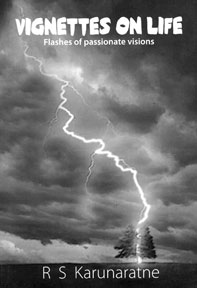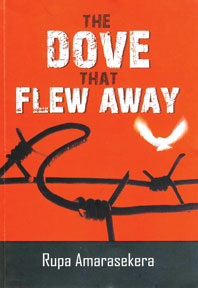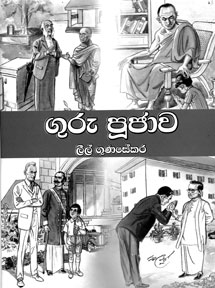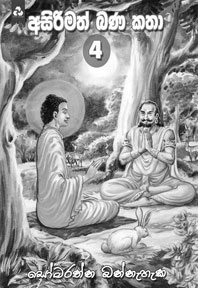|
Essays to read and ruminate over:
Flashes of passionate visions
Reviewed by S. Anton J. Jesuthasan (Sajj)

Vignettes on Life
Author: R. S. Karunaratne
Sarasavi Publishers
|
This is another gem of a book by R.S. Karunaratne. It is a collection
of essays in which RSK has distilled his wisdom gained over the years of
learning and experience. This is a book I found difficult to put down. I
obtained the book wanting to review it, and found that the first chapter
contained a most instructive lesson on book reviewing. Did I count
myself fortunate? Or did it leave me hamstrung?
I had reviewed two of his books previously. Reviewing is generally
not an easy task but it turns into a pleasurable journey when it comes
to RSK’s writings.
RSK notes in his preface that essays are a piece of writing
illustrating one’s opinion, and the essayist plays the part of
philosopher and critic. I find that this medium lends great freedom to
the writer to say what he likes. The reader has as much freedom to agree
or disagree.
The essay ‘Life begins at 60’ illustrates eloquently how skilfully
the essayist plays his role. While some people claim that life begins at
30, 40 or 50, he avers that life begins at 60! He doesn’t just stop
there. He illustrates his point citing the greatest Greek philosopher
Plato who was learning and teaching in his eighties, and Socrates
becoming a brilliant orator in his 94th year! He does not forget some
Sri Lankans of this ilk either.
“You might argue that you are not going to live so long”, he says.
“That means you have conditioned your mind to die young. Apart from
accidents and major illnesses, this is another reason why people die as
soon as they retire from work. To quote Alexander Pope’s words, “what
oft was thought but never so well expressed.”
Rules of thumb for trouble-free living is RSK’s vintage, yet
disparate, vignettes. Need I mention that rule of thumb is not keeping
your wife strictly under your thumb, it means, “a fairly accurate guide
based on practice rather than theory.”
A rule of thumb for journalists, borrowed from one of his own
seniors: “kill everything you don’t understand.” How can an ordinary
reader understand what a journalist cannot, he reminds them. If only
journalists would heed this advice! Do we not encounter in the media
today, opinion and comment that wouldn’t pass muster. Does what you hear
and print or broadcast make any sense whatever?
Speaking of choice between two examination questions, he tells the
student another rule of thumb: “When in doubt leave it out.”
Commenting on visiting cards that detail a person’s qualifications,
position, etc., he says, “Well, the longer your job title, the less
important you are!” Had I read this book earlier, I may not have given
him my card, but mine is social-cum-business card, and most people want
to know as much about you as possible the moment they meet you, else
follow some searching and embarrassing moments.
Trite in places, you may say, but remember Pope above. I for one do
not desist from reminding one of what one may already know only too
well.
In today’s troubled world that’s starved of integrity and brims with
a surfeit of dishonesty, where journalism has become “the weapon of mass
destruction” in the hands of skilled “spin doctors” the world over, the
straight and honest within this veteran journalist proclaims:
“If people have scant respect for the printed word (I would add
‘broadcast’), writers are also responsible to a great extent. Many
writers have prostituted their talents for financial or political gains.
It is a tragedy that these people do not realize that it is detrimental
to the healthy growth of the future generations.” Yes, isn’t concern for
our progeny a hallmark of our culture?
“It is dishonest and crooked writing that has made readers doubt the
printed word. If all the writers make use of their talents honestly,
people will still believe the printed word,” affirms RSK.
Many readers would also, I think, love to read his views on Super
Powers “Charter of Human Rights in their right hand, preach(ing)
disarmament,” while keeping their left hand on the controlling keys of
the arsenals.” His phraseology, “world peace and brotherhood become not
mere nonsense, but nonsense on stilts is very telling.”
Many who may not have considered poetry a faithful mistress (in the
pure sense of the word), may, when they read this essay, find themselves
courting this mistress even late in their lives.
Quoting from Alfred Noyes’ popular poem “The Highwayman”:
“The wind was a torrent of darkness among the gusty trees,
The moon was a ghostly galleon tossed upon cloudy seas.”
The highwayman came riding, up to the old inn-door” and declaring
that he heard the galloping sound of a horse just outside the classroom
as his teacher Max Perera read out the poem to his class so effectively,
RSK does not only illustrate the power of rhyme, rhythm and imagery to
his own readers, he also evokes nostalgia in those who have themselves
heard such poems read to them in class, and experienced another world.
Prose can be beautiful, but poetry is sublime, argues RSK.
His introducing the reader to Sri Lanka’s own poets whose poetry
uplifts the reader merely with just the right words and emotion devoid
of rhyme or rhythm also serves a noble aim.
One must study the chapter on “English, The language of the world,”
not just read it, to understand RSK’s underlying lament over the loss
this country suffers, failing to foster English learning. This chapter
is also a lesson in classic English composition, which anyone claiming
to know the language should no doubt aim to emulate. “English is not an
easy language to learn,” says the writer. “English is a noble language
which possesses one of the finest literatures in the world.” So let’s
learn it well.”
One can see the essay on J. Krishnamurti is the author’s tribute to
his revered sage. I cannot do better than urge readers of this review to
read this tribute first before moving on to read Krishnamurti, no matter
they understand him first time or not, for his words and thoughts can be
as difficult, as they are rewarding.
There are fifty clusters of vignettes in this edition of the book. I
say clusters advisedly. Space limitation restrains me from touching on
every one of them. But I cannot conclude without adverting to two more
of these.
In “A new look at love,” the writer is obviously dealing with love
between persons of opposite sexes. Although a reader may wish for the
chapter to have encompassed love on a wider basis, mother’s love, filial
love, love for humanity, if only to hear the writer’s thoughts on them,
the concluding words of the chapter, “From whatever angle you look at
it, love is the most elusive of all emotions because it is many
splendoured,” can only be seen as truly memorable words.
Finally, “On looking back”, the writer reflects on his “beginnings”,
his childhood, his progress through life with its simple and innocent
pleasures and experiences, and his gratitude to persons and institutions
that had contributed to what he is today. This is a tender and touching
account that will pull at the heartstrings of many who may identify with
him in some form when reading his words.
The words “50 of the essays” in the preface suggests there are more
out there. I would love to see them in print, in another book form,
soon.
For a better understanding of life
Reviewed by Sita Kulatunga
 Rupa
Amarasekere has been a prolific writer both in Sinhala and English. Most
of her works are children’s stories based on our own culture. However, I
have reservations about using the word prolific - because there are
prolific writers in this day and age, whose friends claim that they turn
out a novel overnight - particularly in Sinhala. Rupa
Amarasekere has been a prolific writer both in Sinhala and English. Most
of her works are children’s stories based on our own culture. However, I
have reservations about using the word prolific - because there are
prolific writers in this day and age, whose friends claim that they turn
out a novel overnight - particularly in Sinhala.
Though prolific, Rupa is not a writer of pot-boilers. She is a
serious writer who brings the insight and craftsmanship that creative
writing deserves. Children’s books, Rupa’s forte demands introspection,
creativity and of course a sense of social responsibility. Rupa’s
children’s books envelope a wide variety of subjects that range from
‘Kompittu Idiyo’ to Galileo Galilee and Dinosaur Land. She has done a
number of translations from English to Sinhala and vice versa.
Her work includes an English translation of Kusa Jathaka Kavyaya.
Rupa is a perceptive writer with insight. Her education experience
and ability to come to terms with the tests of life are reflected in her
work perhaps her recent prolonged illness has strengthened her to accept
the wheel of samsara.
Kalabhooshana Rupa Amarasekera entered University of Peradeniya in
1956 - in the heyday of Peradeniya’s creativity when she had the good
fortune of getting her work critiqued by Prof. E.R. Sarachchandra in
Nirmana workshops.
Her first novel ‘Yugayaka Peraliya’ was awarded the Martin
Wickramasinghe birth centenary award in 1990, and her book towards a new
home was awarded the state literary award for the best children’s book
in English.
The Dove that flew away (published by Sarasavi Publishers) contains
ten short stories of varying length. They deal with diverse
circumstances and deeply engrossing social issues; a whole gamut of
national, ethnic, class and creed involvements depicted through a
deceptively simple medium. They are handled with sensitivity and in a
manner that makes the reader think. Sometimes complex issues are brought
down to simple terms that make them all the more human for that.
In the title story the dove..., we find: “What’s your name? queried
Nalini shyly from the big eyed thin girl in the long pawadai, skirt,
with the flowers and red jacket.... Nalini was fascinated, when she set
her eyes on her for the first time. She had just got up from her sleep
in the morning, as they were lying on the same mat on the floor.
“Rajini” she replied meekly. “I’m Nalini” she smiled.
A story that I found extremely touching was ‘The Journey’. In it at
the outset different groups of people travelling in a train compartment
are juxtaposed - cricketers, a married couple - the narrator and her
husband and the protagonist dressed in full suit and a hat (unusual for
the sixties) reading the Daily News:
The short story ‘The till’ is a very short one. It deals with a
war-time encounter poignantly described but what is left unsaid here is
most important and revealing.
Rupa has the special gift of bringing the rural atmosphere of the
bygone days to life. In the Dying Embers and in several others we find
these very genuine descriptions of the Sri Lankan village. The village
is not romanticized or its virtues exaggerated. The end of this story
summarizes a holistic attitude to life. A stoic Buddhist acceptance of
ashtalokadharma in the flux of time. Though in a simple way, she depicts
an understanding of life and human nature that is comprehensive and
universal which penetrates below social interaction.
Compendium of morals and concepts
Reviewed by Nimal Ranatunga
|

Guru Poojawa
Author:
Dr. Leel Gunasekara
|
Revered traditions held in high esteem in the past are rapidly
deteriorating owing to vicissitudes of diverse social changes. This had
created a negative impact on the ethical and spiritual values.
The highly valued traditions of respecting and venerating the
teachers, parents and the elderly are getting eroded among the youth.
Dr. Leel Gunasekara had made a sincere endeavour to arrest this
sordid situation by launching his latest book “Guru Poojawa”, a special
book for the youth.
He was able to accomplish this crucial task as he is a luminary with
creativity, polite learning and perspicacity. He won the State Award for
his popular novel “Pethsama” in 1961.
The objective of the writer is to inculcate positive attitudes in
children relating to our traditionally esteemed cultural values which
tend to disappear at present. This he does by citing the most
dascinating instances in lives of a few distinguished and eminent
personalities of the recent past.
These great personages are the most Venerable Hikkaduwe Sri Sumangala
Nayaka Thera, Most Ven. Ratmalana Dhammarama Nayaka Thera, Sir D.B.
Jayathilaka, Dr. C.W.W. Kannangara - father of free Education, Professor
G.P. Malalasekara, Pandit Sri Devarakshitha of Batuwanthudawe, P. De S.
Kularatna former Principal of Ananda College Colombo, Syril Janz
ex-principal of St. John’s College, Panadura and Terrance S. De Silva of
Kolonnawa.
The author emphatically stresses the fact that these personages of
high repute deserve the pioneer adoration and respect. They are
recognised as eminent teachers and mentors who have served the country
extremely well.
Dr. Gunasekara has apparently deviated from the usual pattern of his
writing and had adopted a new creative style in keeping with the
seriousness necessary. This is due to the fact that “Guru Poojawa”
enlightens and educates our younger generation on the importance of
respecting and being grateful to great teachers of our time.
The language which has enriched the book has captured the mind and
the heart of the child as it is clear, attractive and simple. The
diction is lucid and readable; the technique elegant and creative. At
certain points the language also bears the semblance of the day to day
parlance of the children.
One exceptional feature of his book is that it is a collection of
delightful pictures to illustrate the author’s ideas and concepts. This
has won the admiration of the children. When they see these pictures
spontaneously a propensity is emerged in the child to read the contents
of the book.
The child becomes curious to know the accomplishments of these great
personalities. Finally the child becomes extremely ambitious and aspires
to emulate them and to engage in such noble and incomparable deeds when
he enters society as an adult.
The book exerts a strong influence on the child while the author
inspires younger generation to follow the worthy examples set by great
personages. The book is an eye opener to parents and teachers.
This book is a compendium of morals and concepts that could mould the
life of the younger generation.
The book is important to the reader from the perspective of creative
fulfilment which paves the way for inter-generational co-operation. Guru
Pooja is an important contribution to decent social well-being.
The writer is Director - Education Dept. Help Age Sri Lanka.
“Asirimath Bana Katha - 4”
 Somaratne
Banneheka’s latest Buddhist book “Asirimath Bana Katha - 4” will be
launched at Dayawansa Jayakody Book Exhibition Hall, Ven. S. Mahinda
Mawatha, Colombo 10 on March 9 at 10 a.m.. Somaratne
Banneheka’s latest Buddhist book “Asirimath Bana Katha - 4” will be
launched at Dayawansa Jayakody Book Exhibition Hall, Ven. S. Mahinda
Mawatha, Colombo 10 on March 9 at 10 a.m..
Banneheka is the author of “Asirimath Bana Katha - 1, Asirimath Bana
Katha - 2 and Asirimath Bana Katha - 3”.
“Asirimath Bana Katha - 4” is a Dayawansa Jayakody publication. |

